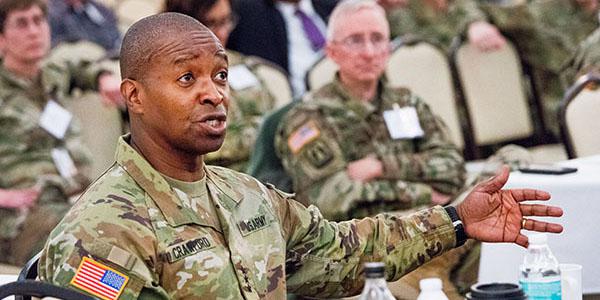Army Transforms Today to Modernize Tomorrow
The U.S. Army’s ambitious modernization plan requires revamping the service’s technology development and acquisition processes to shape future combat capabilities.
Officials are creating a Futures Command with eight cross-functional teams (CFTs) to focus on six modernization priorities, including a more efficient and survivable network.
At the recent AFCEA Army Signal Conference in Springfield, Virginia, Army leaders described a do-it-all, Swiss army knife version of a network. Lt. Gen. Paul Ostrowski, USA, principal military deputy to the assistant secretary of the Army for acquisition, logistics and technology and director of the Army Acquisition Corps, said the network must be mobile, expeditionary, resilient, available, reliable, simple, intuitive, standards-based, upgradeable, accessible to allies, difficult for adversaries to detect, capable of communications on the move and usable as a weapon. Lt. Gen. Laura Richardson, USA, deputy commanding general and chief of staff for Forces Command, added that soldiers must be able to set up and tear down command posts in about 30 minutes.
Lt. Gen. Bruce Crawford, USA, Army chief information officer/G-6, said the transformation must be comprehensive. “This journey is about fundamentally changing how the network is used. And, more importantly, [it is] fundamentally changing not just what we buy, but how we buy it,” Gen. Crawford said. “We’re dealing with the requirements process. We’re dealing with a lack of understanding institutionally of what capabilities are available. We’re dealing with a lot of policy issues that really are not optimized.”
Regarding the requirements process, the CFTs receive feedback from soldiers early and often to ensure technology is mature before being included in a program of record. In addition, each CFT reports directly to the undersecretary of the Army and the service’s vice chief of staff to “get rid of stovepipe systems” and to avoid bureaucracy, Gen. Richardson reported.
“We have to leverage commercial innovations, cutting-edge science and technology, prototyping and warfighter feedback,” she continued.
The service restructured its Army Requirements Oversight Council, which now includes more developers and users of Army systems. “It’s pretty important to the way that we’re going to do business,” said Maj. Gen. John George, USA, force development director, Office of the Army Deputy Chief of Staff, G-8.
Officials also touted the “IT box” concept, which allows requirements decisions to be made at lower levels. “We’re looking into that heavily in the offensive cyber arena to allow us to continue to … adapt and generate new capabilities,” said Laurence Mixon, special assistant to the Program Executive Office for Intelligence, Electronic Warfare and Sensors.
Additionally, the service seeks to capture commercial innovation delivered by nontraditional contractors that do not normally conduct business with the Defense Department. Of roughly 23 million U.S. companies, only about 5,000 do business with the department, Gen. Ostrowski pointed out. “That’s a lot of companies we’re not tapping into—a lot of innovation out there we’re not grabbing,” he said.
Maj. Gen. John Ferrari, USA, director, program analysis and evaluation, Office of the Army Deputy Chief of Staff, G-8, commented further that the Army could suffer a setback if sequestration returns. “I can’t tell you that in 2020 there will be another budget deal,” Gen. Ferrari said. “We’re like squirrels in winter gathering up chestnuts, not knowing when the next storm’s coming.”
For more from the AFCEA Army Signal Conference, go to event.afcea.org/signalconference18





Comments